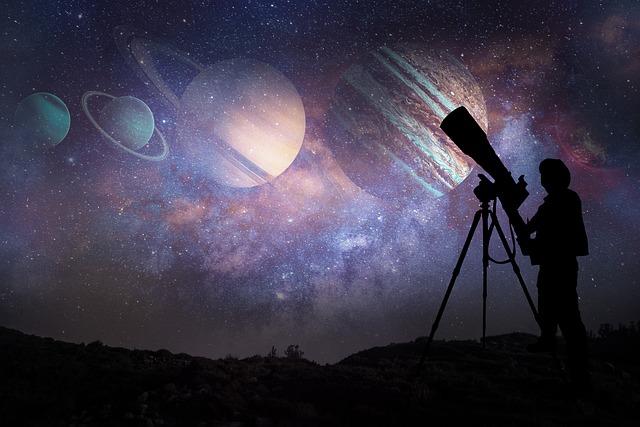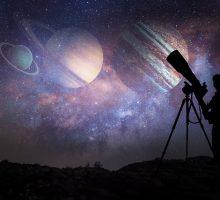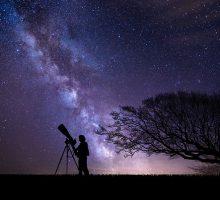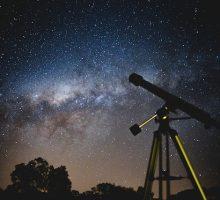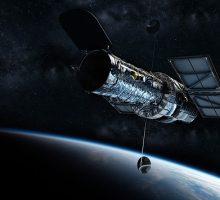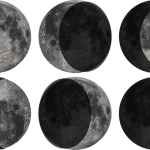- The history of telescopes: From Galileo to Hubble
- Refracting vs reflecting telescopes: What’s the difference?
- Choosing the right telescope: Tips for beginners
- The role of telescopes in space exploration
- The biggest telescopes in the world: A tour of the top observatories
- The future of telescopes: Advancements in technology and research
- Understanding the different types of telescopes: Radio, X-ray, Gamma ray, and more
- The impact of telescopes on our understanding of the universe
- The science behind telescopes: How they work and what they can teach us
- The art of astrophotography: Capturing the beauty of the universe with a telescope
- Conclusion
The History of Telescopes: From Galileo to Hubble
Telescopes have played a crucial role in our understanding of the universe. They have helped us discover new planets, galaxies, and stars, and have enabled us to study the properties of light and matter in greater detail. But where did it all begin? Let’s take a trip back in time and explore the history of telescopes, from the early days of Galileo to the modern era of the Hubble Space Telescope.
In the early 1600s, the Italian astronomer Galileo Galilei made one of the most significant discoveries in the history of astronomy. Using a primitive telescope that he had built himself, Galileo observed the moons of Jupiter and the phases of Venus, which provided evidence for the heliocentric model of the solar system. Galileo’s observations revolutionized our understanding of the cosmos and helped usher in the age of modern astronomy.
In the following centuries, telescopes continued to evolve and improve. In the 18th and 19th centuries, astronomers began using refracting telescopes, which used lenses to bend and focus light. One of the most famous refracting telescopes is the Great Refractor at the Yerkes Observatory in Wisconsin, which has a lens nearly 40 inches in diameter.
In the 20th century, reflecting telescopes, which use mirrors to reflect and focus light, became more popular. One of the most famous reflecting telescopes is the Hubble Space Telescope, which was launched into orbit in 1990. The Hubble has captured some of the most stunning images of the cosmos ever seen, from the Pillars of Creation in the Eagle Nebula to the Hubble Deep Field, which revealed thousands of galaxies in a single image.
But telescopes aren’t just for professional astronomers. Today, amateur astronomers can purchase high-quality telescopes for relatively low prices and explore the night sky from their own backyards. Whether you’re looking to observe the planets, stars, or galaxies, a telescope can be an incredibly rewarding tool for exploring the cosmos.
Refracting vs Reflecting Telescopes: What’s the Difference?
Telescopes come in all shapes and sizes, but there are two main types: refracting and reflecting telescopes. Each has its own advantages and disadvantages, and understanding the differences between them can help you choose the right telescope for your needs.
Refracting telescopes, also known as refractors, use lenses to bend and focus light. The first refracting telescopes were invented in the early 1600s by Galileo and Johannes Kepler, and they were quickly adopted by astronomers around the world. Refractors have a simple design and are relatively easy to use, making them a popular choice for beginners.
Reflecting telescopes, on the other hand, use mirrors to reflect and focus light. The first reflecting telescope was built by Isaac Newton in the late 1600s, and it was a major breakthrough in telescope design. Reflectors are often larger and more complex than refractors, but they can also be more powerful and offer a wider field of view.
So, what are the main differences between refracting and reflecting telescopes?
One key difference is the way they handle light. Refractors are designed to minimize chromatic aberration, which is the distortion of light that occurs when it passes through a lens. Reflectors, on the other hand, are not subject to chromatic aberration, but they can suffer from other optical issues, such as coma and astigmatism.
Another difference is the cost and size. Refractors tend to be smaller and less expensive than reflectors of comparable quality, making them a good choice for those on a budget or with limited space. Reflectors, however, can be much larger and more powerful than refractors, making them the preferred choice for serious astronomers and astrophotographers.
Finally, the way the two types of telescopes are constructed is different. Refractors have a long, thin tube with a lens at one end, while reflectors have a wider, shorter tube with a mirror at the bottom. This design difference can affect the way the telescopes are mounted and used, as well as the overall stability and durability of the telescope.
Choosing the Right Telescope: Tips for Beginners
Telescopes are a fantastic tool for exploring the cosmos and discovering the wonders of the universe. However, for beginners, the process of choosing the right telescope can be daunting. With so many different types, sizes, and features available, how do you know which one is right for you? Here are some tips to help you choose the best telescope for your needs.
- Consider your budget: Telescopes come in a wide range of prices, from a few hundred dollars to several thousand. Before you start shopping, decide how much you’re willing to spend. Remember, you’ll also need to factor in the cost of accessories like eyepieces, filters, and a mount.
- Think about your observing goals: What do you want to observe with your telescope? Planets, stars, galaxies, or all of the above? Different types of telescopes are better suited for different types of objects, so it’s important to have a clear idea of your observing goals before you start shopping.
- Choose the right type of telescope: There are three main types of telescopes: refractors, reflectors, and catadioptric (or compound) telescopes. Refractors use lenses, reflectors use mirrors, and catadioptric telescopes use a combination of lenses and mirrors. Each type has its own strengths and weaknesses, so choose the one that best fits your observing goals and budget.
- Consider the size of the telescope: The size of the telescope’s aperture (the diameter of its primary lens or mirror) is an important factor in its performance. Generally, the larger the aperture, the better the telescope’s light-gathering ability and resolution. However, larger telescopes are also heavier, bulkier, and more expensive, so you’ll need to find a balance between performance and portability.
- Don’t forget about the mount: A good mount is essential for any telescope. It should be stable, sturdy, and easy to use. Look for a mount that’s rated for the weight of your telescope, and consider one with a motorized tracking system to help you keep objects in view.
- Try before you buy: If possible, try out a telescope before you buy it. Many astronomy clubs and observatories offer public observing nights where you can test different types of telescopes and get advice from experienced astronomers.
The Role of Telescopes in Space Exploration
Telescopes have played a crucial role in space exploration, from helping us understand our own solar system to discovering the most distant galaxies in the universe. Whether on the ground or in space, telescopes have enabled us to see further and more clearly than ever before, unlocking the secrets of the cosmos.
One of the most important roles telescopes play in space exploration is in the search for exoplanets, planets outside our own solar system. Telescopes like Kepler, TESS, and the upcoming James Webb Space Telescope are designed to detect the faint signals of exoplanets as they pass in front of their host stars. These observations have already led to the discovery of thousands of exoplanets, including many that are potentially habitable.
Telescopes also play a vital role in studying the universe’s origins and evolution. The Hubble Space Telescope, for example, has helped astronomers measure the expansion rate of the universe, map the distribution of dark matter, and observe the most distant galaxies in the universe. The upcoming James Webb Space Telescope will take these observations even further, allowing us to study the first galaxies that formed after the Big Bang and investigate the nature of dark matter and dark energy.
Telescopes are also critical for studying our own solar system. The Cassini spacecraft, equipped with a powerful imaging system, was able to capture stunning images of Saturn and its moons, revealing their complex geology and providing insights into the history of our solar system. The upcoming Europa Clipper mission will use a suite of instruments, including cameras and spectrometers, to study Jupiter’s moon Europa and search for signs of life.
Even ground-based telescopes play a vital role in space exploration. The Atacama Large Millimeter Array (ALMA), located in Chile, is a collection of 66 radio telescopes that work together to study the birth of stars and planets in distant galaxies. Other ground-based telescopes, like the Keck Observatory in Hawaii and the Very Large Telescope (VLT) in Chile, are equipped with sophisticated adaptive optics systems that compensate for atmospheric distortion, allowing for incredibly sharp images of distant objects.
The Biggest Telescopes in the World: A Tour of the Top Observatories
Observatories are home to some of the most powerful telescopes in the world, allowing us to observe and study objects in the universe that are billions of light-years away. From the world’s largest optical telescope to the most sensitive radio telescope, let’s take a tour of the top observatories in the world.
- The Gran Telescopio Canarias (GTC) – Located on the island of La Palma in Spain’s Canary Islands, the GTC is the world’s largest optical telescope. With a mirror diameter of 10.4 meters, the GTC is capable of observing objects with unprecedented detail and sensitivity.
- Keck Observatory – Situated atop Mauna Kea in Hawaii, the Keck Observatory consists of two telescopes, each with a mirror diameter of 10 meters. The telescopes are equipped with sophisticated adaptive optics systems that compensate for atmospheric distortion, allowing for incredibly sharp images of distant objects.
- Atacama Large Millimeter Array (ALMA) – Located in the Atacama Desert in Chile, ALMA is a collection of 66 radio telescopes that work together to study the birth of stars and planets in distant galaxies. ALMA is the most sensitive radio telescope in the world, capable of detecting radio waves emitted by objects billions of light-years away.
- Very Large Telescope (VLT) – Situated in Chile’s Atacama Desert, the VLT consists of four 8.2-meter telescopes that can work together to observe the same object simultaneously. The VLT is equipped with advanced instrumentation that allows astronomers to study the properties of distant objects in unprecedented detail.
- Gemini Observatory – Located on two separate sites, one in Hawaii and one in Chile, the Gemini Observatory consists of two 8.1-meter telescopes that work together to observe the universe in both the northern and southern hemispheres. The telescopes are equipped with a suite of instruments that allow astronomers to study everything from distant galaxies to exoplanets.
- Large Binocular Telescope (LBT) – Situated on Mount Graham in Arizona, the LBT is equipped with two 8.4-meter mirrors that work together to provide images with the sharpness of a single 22.8-meter mirror. The LBT is equipped with a range of instruments, including a spectrograph that can analyze the chemical composition of distant objects.
- Arecibo Observatory – Located in Puerto Rico, the Arecibo Observatory was the world’s largest radio telescope until its collapse in 2020. The observatory was famous for its contributions to the search for extraterrestrial intelligence and the study of near-Earth objects.
The Future of Telescopes: Advancements in Technology and Research
Telescopes have been critical tools for astronomers for centuries, but advancements in technology and research continue to shape the future of these powerful instruments. From the development of new telescopes with unprecedented capabilities to advancements in data analysis and artificial intelligence, let’s explore how the future of telescopes is shaping up.
- New Telescopes
The development of new telescopes is one of the most exciting areas of innovation in the field. The upcoming James Webb Space Telescope (JWST) is set to launch in 2021 and will be the largest and most powerful space telescope ever built. It will be capable of observing the universe in infrared light, allowing astronomers to study the earliest galaxies and stars that formed after the Big Bang.
Other new telescopes currently in development include the Giant Magellan Telescope (GMT), which will have a mirror diameter of 25 meters, and the Thirty Meter Telescope (TMT), which will have a mirror diameter of 30 meters. These new telescopes will allow astronomers to study the universe in unprecedented detail and sensitivity.
- Data Analysis
As telescopes become more powerful, the amount of data they generate also increases dramatically. To analyze this data, astronomers are developing new techniques and tools, including machine learning and artificial intelligence. These tools can help automate the analysis process and identify patterns that might otherwise be missed.
For example, the Dark Energy Survey (DES) used machine learning algorithms to sift through millions of galaxy images and identify rare, distant objects that would have been difficult to find otherwise. These advancements in data analysis are opening up new avenues of research and allowing astronomers to make discoveries more efficiently.
- Multi-Messenger Astronomy
Traditionally, astronomy has relied on observations of light in various forms, including visible light, radio waves, and X-rays. However, in recent years, astronomers have begun to study the universe using multiple “messengers,” including gravitational waves and high-energy particles.
The Laser Interferometer Gravitational-Wave Observatory (LIGO) made history in 2015 by detecting gravitational waves, ripples in space-time caused by massive objects like black holes colliding. Since then, other observatories have joined in the search for gravitational waves, including the Virgo detector in Italy and the KAGRA detector in Japan.
By studying the universe using multiple messengers, astronomers can gain a more complete picture of the cosmos and learn about phenomena that might not be visible using traditional telescopes.
Understanding the Different Types of Telescopes: Radio, X-ray, Gamma Ray, and More
When most people think of telescopes, they likely picture optical telescopes that use visible light to observe the cosmos. However, there are actually many different types of telescopes, each of which observes the universe in a different way. In this article, we’ll explore the different types of telescopes, including radio, X-ray, gamma-ray, and more.
- Optical Telescopes
Optical telescopes are the most common type of telescope and use visible light to observe the universe. These telescopes come in two main types: refracting and reflecting telescopes. Refracting telescopes use lenses to focus light, while reflecting telescopes use mirrors.
- Radio Telescopes
Radio telescopes use radio waves to observe the universe. These telescopes are typically large and have a parabolic dish or array of dishes to collect the radio waves. They are useful for studying the universe in ways that optical telescopes cannot, such as observing cold gas clouds and detecting pulsars.
- X-ray Telescopes
X-ray telescopes observe the universe using X-rays, which are high-energy electromagnetic radiation. X-ray telescopes typically use grazing incidence mirrors to focus the X-rays onto a detector. These telescopes are useful for studying high-energy phenomena, such as black holes and supernovae.
- Gamma Ray Telescopes
Gamma ray telescopes observe the universe using gamma rays, which are the highest-energy form of electromagnetic radiation. These telescopes typically use a detector made of scintillating material to detect gamma rays. Gamma ray telescopes are useful for studying high-energy phenomena, such as gamma ray bursts and pulsars.
- Infrared Telescopes
Infrared telescopes observe the universe using infrared light, which has longer wavelengths than visible light. These telescopes are useful for studying objects that are too cool to emit visible light, such as dust clouds and newly formed stars.
- Ultraviolet Telescopes
Ultraviolet telescopes observe the universe using ultraviolet light, which has shorter wavelengths than visible light. These telescopes are useful for studying hot, young stars and the interstellar medium.
- Neutrino Telescopes
Neutrino telescopes observe the universe using neutrinos, which are subatomic particles that rarely interact with matter. These telescopes are typically located deep underground or underwater to shield them from other particles. Neutrino telescopes are useful for studying high-energy phenomena, such as supernovae and black holes.
The Impact of Telescopes on Our Understanding of the Universe
Telescopes have revolutionized our understanding of the universe. By allowing us to see objects and phenomena that are invisible to the naked eye, telescopes have enabled us to study the cosmos in unprecedented detail. In this article, we’ll explore the impact of telescopes on our understanding of the universe.
- Discovering New Objects
One of the most significant impacts of telescopes has been the discovery of new objects in the universe. Telescopes have allowed astronomers to observe distant galaxies, nebulae, and other celestial objects that were previously unknown. For example, the Hubble Space Telescope has revealed the existence of numerous galaxies beyond the Milky Way, including some of the most distant objects in the universe.
- Measuring Distances
Telescopes have also allowed astronomers to measure distances in the universe with great precision. By observing the brightness and motion of stars and galaxies, astronomers can determine their distances from Earth. This has allowed us to create detailed maps of the universe and to better understand the structure and evolution of the cosmos.
- Studying the Properties of Objects
Telescopes have also enabled astronomers to study the properties of celestial objects in great detail. By analyzing the light emitted by stars, galaxies, and other objects, astronomers can determine their composition, temperature, and other properties. This has allowed us to learn more about the physical processes that govern the universe.
- Observing Cosmic Events
Telescopes have also allowed us to observe cosmic events in real-time. For example, telescopes have been used to observe supernovae, black holes, and other phenomena that were previously only known through theory. By studying these events, astronomers can better understand the processes that drive the universe.
- Advancing Our Understanding
Overall, the impact of telescopes on our understanding of the universe has been immense. Telescopes have allowed us to study the universe in ways that were previously impossible, and they continue to push the boundaries of what we know about the cosmos. From discovering new objects to measuring distances and studying the properties of celestial objects, telescopes have played a crucial role in advancing our understanding of the universe.
The Science Behind Telescopes: How They Work and What They Can Teach Us
Telescopes are powerful tools that allow us to study the cosmos in ways that are impossible with the naked eye. But how do telescopes work, and what can they teach us about the universe? In this article, we’ll explore the science behind telescopes and what they can teach us.
- The Basic Components of Telescopes
Telescopes have two main components: the objective and the eyepiece. The objective is the main lens or mirror that collects light from distant objects, while the eyepiece magnifies the image produced by the objective. In addition, telescopes often have additional components such as filters and focal reducers, which allow astronomers to modify the image produced by the telescope.
- How Telescopes Collect and Focus Light
Telescopes work by collecting and focusing light from distant objects. Refracting telescopes use a lens to bend and focus the light, while reflecting telescopes use a mirror to reflect and focus the light. Both types of telescopes can produce clear and detailed images of celestial objects, but they have different advantages and disadvantages.
- What We Can Learn from Telescopes
Telescopes can teach us a great deal about the universe. By studying the light emitted by stars, galaxies, and other objects, astronomers can determine their composition, temperature, and other properties. This allows us to learn more about the physical processes that govern the universe. Telescopes also allow us to study the structure and evolution of the universe, from the smallest particles to the largest galaxies.
- The Future of Telescopes
Advancements in technology are allowing telescopes to become even more powerful and capable of observing the universe in ever-greater detail. For example, the James Webb Space Telescope, set to launch in 2021, will be able to see further into the universe than any telescope before it. Additionally, new techniques such as interferometry, which allows multiple telescopes to work together as one, are allowing astronomers to create even more detailed images of celestial objects.
The Art of Astrophotography: Capturing the Beauty of the Universe with a Telescope
Astrophotography is the art of capturing images of celestial objects using a telescope and a camera. With advances in technology, amateur astronomers can now capture breathtaking images of stars, galaxies, and other celestial objects. In this article, we’ll explore the art of astrophotography and how you can capture the beauty of the universe with a telescope.
- The Equipment You’ll Need
To get started with astrophotography, you’ll need a few key pieces of equipment. First and foremost, you’ll need a telescope. Reflecting telescopes are generally preferred for astrophotography because they have a larger aperture and are better suited for long-exposure photography. You’ll also need a camera with manual settings, a tripod, and a remote shutter release. Additionally, you may want to invest in filters and a tracking mount to improve the quality of your images.
- Techniques for Capturing Great Images
Capturing great astrophotography images requires a bit of skill and patience. One of the most important techniques is to take long-exposure shots, which allow more light to be captured and reveal more detail in the image. You’ll also want to use a low ISO setting to minimize noise in the image. Additionally, using filters can help to improve contrast and color in the final image.
- Post-Processing Your Images
After capturing your images, you’ll need to process them to create a final, polished product. This typically involves adjusting the contrast, brightness, and color balance of the image using software such as Adobe Photoshop or Lightroom. You may also want to stack multiple images to create a more detailed final product.
- Examples of Astophotography Images
Astrophotography can produce stunning images that showcase the beauty of the universe. Examples of popular subjects include the Milky Way, star clusters, nebulae, and galaxies. With a bit of practice and the right equipment, anyone can capture breathtaking images of the night sky.
Conclusion
Whether you’re a beginner or an experienced astronomer, these blogs offer valuable insights and tips to enhance your understanding of telescopes and their role in space exploration. From the biggest observatories in the world to the latest advancements in telescope technology, these blogs cover a wide range of topics and showcase the beauty of the universe through astrophotography.
In conclusion, telescopes have played a crucial role in expanding our knowledge of the universe and continue to provide new discoveries and insights. I hope these blogs have been informative and inspiring to all those interested in exploring the mysteries of the cosmos.
ScitechVenture YouTube channel

